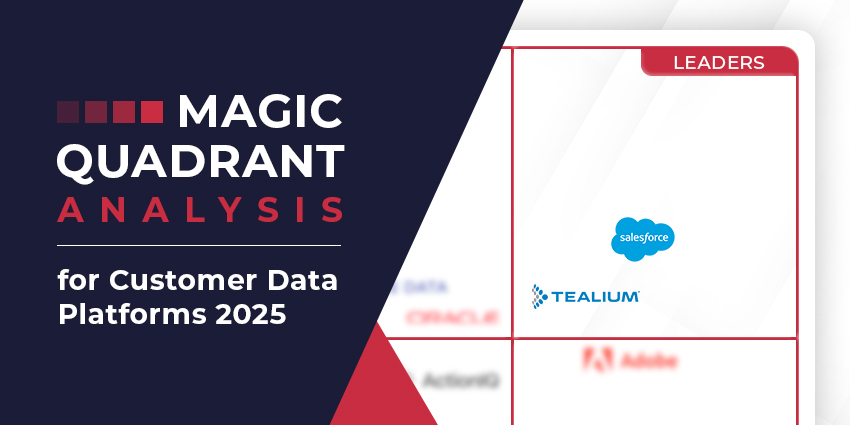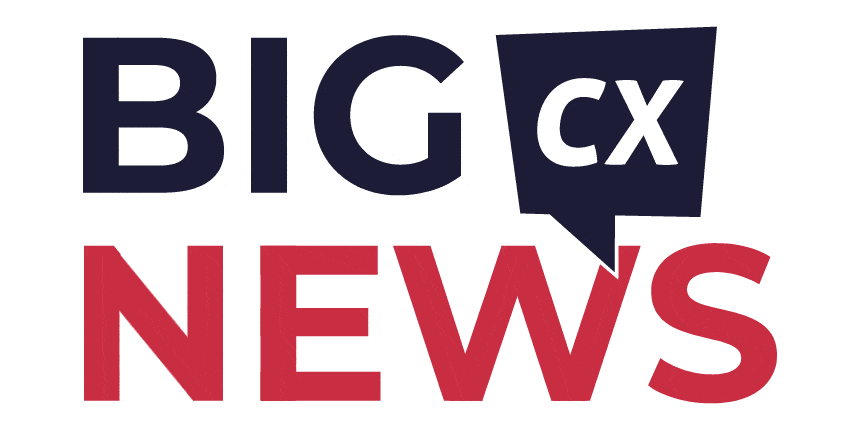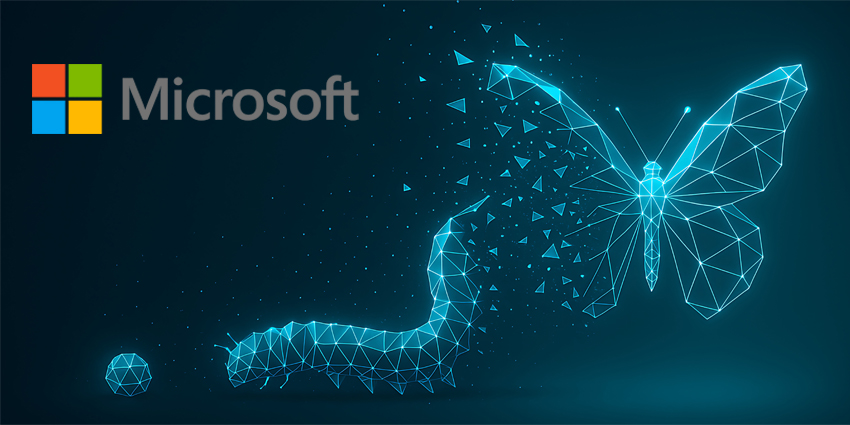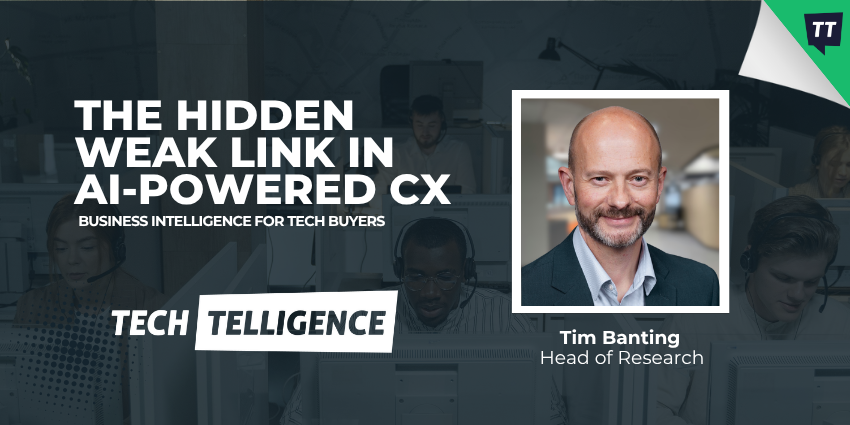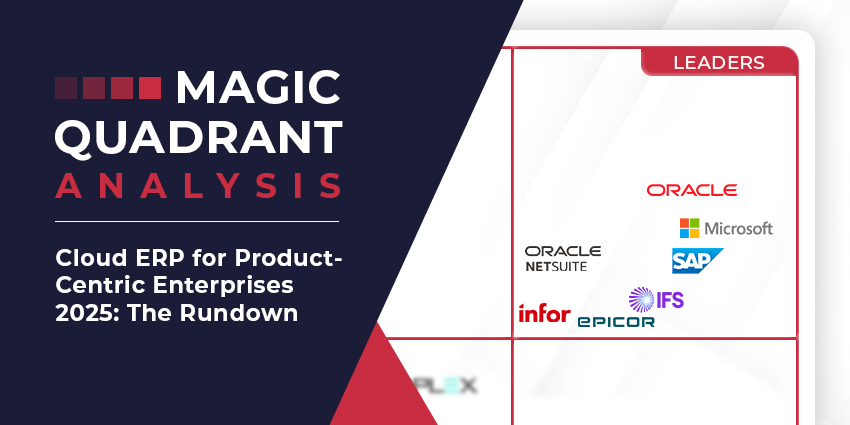In 2025, Salesforce and Tealium again led the Gartner Magic Quadrant for customer data platforms (CDPs).
However, the competition has fallen back, with Treasure Data and Adobe – leaders in last year’s edition – now a challenger and visionary, respectively.
Interestingly, Action IQ, Amperity, and Twilio have dropped from the visionary category. This year, they are all niche players.
Meanwhile, Oracle has switched from a visionary to a challenger.
BlueConic was a challenger in 2024, but it’s now a niche player as almost the entire matrix shifts toward the bottom-left quadrant.
Other CDP vendors have dropped off the grid completely. These include Blueshift, Dun & Bradstreet, Leadspace, Zeotap, and – perhaps most surprisingly – SAP.
Gartner explains that SAP’s CDP revenue didn’t meet the updated inclusion criteria.
No new CDP entrants replaced the five providers that lost their places. Perhaps most notably, Microsoft remains absent with its Dynamics 365 Customer Insights – Data product.
The Definition of a Customer Data Platform (CDP)
Customer data platforms unify systems of record to enable a centralized customer database.
These systems span CRM, CCaaS, WEM, social media management, conversational AI solutions, the company website, and beyond.
In pooling all this data, the CDP funnels it into unified customer profiles and makes it actionable for marketing teams.
However, customer service and sales teams may also leverage a CDP.
Gartner notes that a CDP must include data collection, profile unification, activation, and AI-powered reporting, amongst other common features.
From there, the research firm divides 12 CDP providers into quadrants: leaders, challengers, visionaries, and niche players. Here’s how they performed.
Gartner Magic Quadrant Leaders
Leaders in the Magic Quadrant understand enterprise buyer needs and meet those with specialized services and solutions that are a staple of the organization-wide data ecosystem. They also offer a compelling long-term vision for the CDP category. This year’s leaders are:
- Salesforce
- Tealium
Salesforce
Salesforce earns plaudits for its “platform advantage”. Indeed, it can coordinate data and actions across the front office, with custom integrations to adjacent technologies, such as CCaaS platforms, to effectively leverage cross-functional insights.
The CRM leader’s use of Tableau to enhance the platform’s reporting and dashboards is an excellent example of this platform advantage, which Gartner omits.
Also, the study doesn’t spotlight the platform’s key capability advantages, which include its customer audience targeting and sophisticated selection functionality. Its global coverage is also differentiative.
However, Gartner does acknowledge Salesforce’s “AI and data innovation” and “broad ecosystem support” as core strengths. That ecosystem includes its busy Trailblazer community, which enables advanced learning and skill development alongside peer support.
Tealium
Tealium gains credit for its “real-time zero-party data capture” functionality. That stems from the 2024 launch of Tealium Moments IQ, which collects real-time insights from website visitors.
Gartner also lauds the vendor’s “privacy, consent features” and “clear, flexible pricing and packaging”. The latter includes a default package for potential customers to customize.
Surprisingly, the analyst doesn’t mention its expansive partner ecosystem as a strength, which features many custom integrations that pull data across public and private networks.
Lastly, Tealium commits a large portion of its revenue to research and development (R&D) as it expands the data sources it can access and draw insight from.
Gartner Magic Quadrant Challengers
Challengers in the Magic Quadrant typically shine when coordinating data, unifying profiles, and offering functionality across customer-facing functions. However, their use cases may be more limited than leaders. They may also lack a vision of where CDPs fit into the broad enterprise stack. This year’s challengers are:
- Oracle
- Treasure Data
Oracle
Like Tealium, Oracle draws praise for its “transparent pricing”, with Big Red basing its model on the total number of unique profiles clients store on its Unity CDP. As the solution sits on top of Oracle’s cloud infrastructure, the company may also better manage costs.
Moreover, the tech giant wins acclaim for its “unified commercial experiences” and “B2B segmentation support”. Exemplifying the latter, Oracle offers an Account Profile Explorer, which arranges insights differently across industries and departments.
Gartner doesn’t mention Oracle’s prowess in machine learning, with it offering close to 30 pre-packaged customer behavior intelligence models to derive original insight.
However, the analyst does note several cautions, including its limited zero-copy “data warehouse support” capabilities and “media network integrations”.
Treasure Data
Treasure Data gains acknowledgment for its “technical use-case support”, adding many features for IT teams, not just CX leaders. That’s crucial as the front office increasingly relies on IT in the AI age.
Gartner also commends the vendor for its “global, multi-brand organization support” and “customer success strategy”. As part of the latter, it works closely with clients to prioritize initiatives based on revenue impact.
Meanwhile, the analyst cautions as to Treasure Data’s “pricing” and “market understanding”, highlighting how most of its customers are in the midmarket, despite the vendor’s enterprise focus.
The latter seems harsh. Indeed, Treasure Data proved ahead of its time in orchestrating customer engagements across touchpoints with real-time, advanced decisioning. Given the market’s shift to extend the CDP across the customer lifecycle, the company has been vindicated. However, enterprises have proven slower to make this transition than the midmarket.
Gartner Magic Quadrant Visionaries
Visionaries in the Magic Quadrant embrace emerging functionalities to execute “promising” roadmaps that elevate the CDP within the broader business. Yet, their track record for execution, innovation speed, and product packaging can lag behind market leaders. This year’s visionaries are:
- Adobe
Adobe
Adobe’s “GenAI vision” has allowed it to generate personalized visual content based on the unified customer profiles available within its Real-Time CDP.
Gartner recognizes this as a strength in its study, alongside the tech juggernaut’s “vertical enablement” and “growth”. Indeed, its broader Adobe Experience Platform subscription revenues rose 60 percent year-over-year (YoY).
Another area Gartner could have acknowledged is its data governance strength, with advanced policy management, audience targeting, and orchestration capabilities.
Nevertheless, the analyst does pinpoint several cautions, including its “limited set of packaged integrations” and “platform packaging”. Underlining the latter, Gartner highlights that purchasing Adobe’s CDP “may also require” an investment in its Journey Optimizer solution.
Gartner Magic Quadrant Niche Players
Niche players in the Magic Quadrant have developed a significant market presence. However, they are “struggling to meet enterprise needs,” according to Gartner. Some have also found aligning their offerings with an ideal customer persona tricky. This year’s niche players are:
- ActionIQ
- Amperity
- Redpoint Global
- Twilio
- mParticle
- BlueConic
- Zeta Global
ActionIQ
ActionIQ earns plaudits for its HybridCompute architecture, enabling “data warehouse synergy”, simplifying data pipeline management, and boosting data processing.
The company, which Uniphore acquired in December 2024, also gained praise for its “robust proofs of concepts (PoC)” and “data collaboration”.
However, Gartner fails to mention its focus on composability, which bolsters its data ingestion, management, and governance capabilities.
ActionIQ also differentiates via its commitment to serving IT teams, not just CX leaders.
While the analyst doesn’t acknowledge these strengths, it finds cautions in ActionIQ’s “portfolio breadth” and “vision”, which necessitates innovation from data warehouse providers.
Amperity
Amperity has sustained its laser focus on building precise customer profiles, pulling in data from systems that scale the enterprise with various ingestion and access methods. It also generates multiple complementary customer views.
Surprisingly, Gartner doesn’t recognize this. Instead, it highlights “media and measurement use-case support” and “growth” as core strengths.
The analyst also lauds Amperity’s “tracking and reporting capabilities”, which allow for benchmarking against companies of a similar size, sector, or region.
Nevertheless, Gartner questions the company’s “tech buyer alignment” and “operations”, with Amperity reducing its headcount in each of the past two years.
While that may be the case, Amperity offers a broader range of professional services than most others included in the study, with a deep partner ecosystem.
Redpoint Global
Redpoint Global draws acclaim for its “data privacy” safeguards, encrypting all data on the platform to comply with regulations like GDPR and HIPPA.
Further referenced strengths include its “vertical enablement” and “overall viability”, with Gartner applauding the vendor’s 100+ percent net retention rate, which it has maintained for over four years.
Other strengths the analyst overlooks include its range of deployment options and customer-targeting capabilities, which include AI-powered querying.
However, Gartner criticizes Redpoint Global’s “complex use cases” and low “market visibility”, with none of its Magic Quadrant rivals listing it as a competitor for new business.
Twilio
Twilio leverages its CPaaS heritage to support its Segment CDP with 700 prebuilt connectors, enabling a “flexible customer data ecosystem”.
Gartner underscores this strength alongside Twilio’s “privacy” and “AI transparency controls”. Its AI Nutrition Facts Labels are an excellent example of the latter.
Yet, returning to its CPaaS roots, the company has an opportunity to blend CDP and customer communications uniquely, which could be significant in an AI-agent-led world. After all, it cuts out intermediary software, like a CRM.
While Gartner ignores this potential, it does question Twilio’s “buyer go-to-market alignment” and “growth and direction”. However, having secured its largest-ever Segment deal in 2025, the company hopes to reinvigorate its market momentum.
mParticle
mParticle receives praise for the scope of its GenAI roadmap as it advances its journey analysis, decisioning, and data modeling capabilities.
The vendor, which will soon merge with e-commerce platform provider Rokt, also has strengths in enabling low “total cost of ownership” and its robust “data governance” features.
Another strength Gartner misses is its user-friendly design, which allows non-technical users to engage in somewhat complex data management and analytics activities.
The research firm’s cautions include mParticle’s lack of “vertical depth”, “support for personalization”, and a limited “partner network” that restricts its global reach.
BlueConic
Early market entrant BlueConic helped establish the CDP market and still excels in its “market responsiveness” by listening closely to customers and having them direct its roadmap.
Gartner acknowledges this, alongside its advanced “audience-building capabilities” and “European presence”, with a deep regional employee base offering hands-on support.
BlueConic is also seeking to diversify its platform, as evidenced by its recent acquisition of Jebbit, a creation platform for interactive content that enables first-party data collection.
Nevertheless, the vendor’s growth has proven comparatively slow, with Gartner querying its “overall viability”. The analyst also has concerns over its “product offering strategy” and “vertical focus”.
Zeta Global
Zeta Global once offered disparate marketing tools. Now, it provides a cohesive CDP that excels in its “multichannel data activation” for orchestrated campaigns.
Gartner identifies this strength alongside the provider’s “AI-driven audience building” capability – enabled by its AI assistant, the Zeta Opportunity Engine – and its “service and support network”.
Others not mentioned by Gartner include its data enrichment, identity resolution, and customer targeting capabilities.
However, the analyst cautions as to Zeta Global’s “marketing-centric strategy”, in addition to its “technical user gaps” and extended “time to value”.
Lift the lid on more Gartner Magic Quadrant rundowns by checking out CX Today’s coverage below:
- Gartner Magic Quadrant for Digital Experience Platforms 2025
- Gartner Magic Quadrant for CRM Customer Engagement Center (CEC) 2024
- Gartner Magic Quadrant for Contact Center as a Service (CCaaS) 2024
